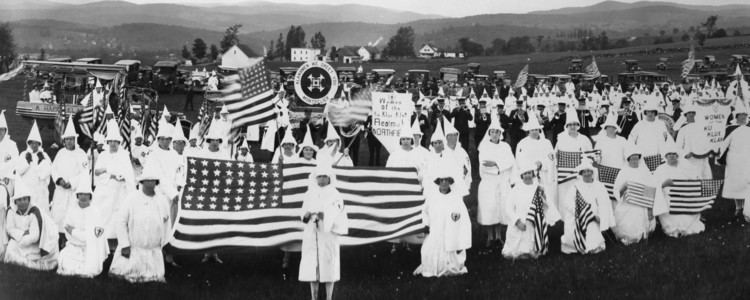The Knights of the Flaming Circle was one of a number of national organizations organized in the 1920s in opposition to the growing influence of the Ku Klux Klan. Unlike many of the other organizations, the Flaming Circle didn't hesitate to fight the Klan's fire with fire. Notable outbreaks of violence took place in the Mahoning Valley of Ohio and in "Bloody Williamson" county of Southern Illinois.
Contents
Prohibition Era
As the Klan focused on the enforcement of Prohibition in the 1920s, immigrant communities without a cultural history of temperance movements, particularly Italians, Catholics and bootleggers joined forces in the Knights of the Flaming Circle.
Ohio

On Aug. 15, 1923, Klan motorcade from East Liverpool, Ohio, and Chester, West Virginia, came downriver to Steubenville, Ohio where they met at a hotel for dinner. Opponents of the Klan, members of the local Flaming Circle gathered outside the hotel. Six or seven cars were overturned and the Klansmen were attacked with bricks, bottles and clubs. Reports noted between 2,500 and 3,000 people participated in the melee. Although many injuries were reported, no deaths seemed to have taken place.
In May 1924, Niles, Ohio the Ku Klux Klan paraded through the city. violence prevented a second parade from taking place the next month in June. The Klan rescheduled for November 1, 1924, and the Knights of the Flaming Circle announced plans for a competing counter-march, promising 10,000 participants. On October 29, someone bombed the home of the city's mayor because he refused to revoke the parade permit. Tensions esclated and resulted in 18 hours of full-blown rioting ended only with 10 days of martial law. Only in the last few years has research focused on Italian-American resources and eyewitness accounts.
New Mexico
Both the Klan and Flaming Circle were active in Raton, New Mexico. Both the fiery cross and a flaming circle in early April 1925 in the days before the local school board election. Both organizations each backed a slate of candidates.
Civil Rights Era
The organization disappeared in the 1930s as the second version of the Klan faded from the public spotlight. It resurfaced in some areas a few decades later though during the Civil Rights Movement. In 1965, Thomas Jordan, a former councilman from Wanaque, New Jersey, announced plans to reorganize the Knights of the Flaming Circle after the re-appearance of the Klan in New Jersey. Following telephone death threats from a voice with a Southern drawl, local police provide Jordan with protection.
On June 9, 1970, Rev. Herman Mohney and Percy McIntyre touched off a burning cross on McIntyre's 44-acre farm near Templeton, Pennsylvania as part of a ceremony for the Flaming Circle. The pair claimed to have more than 500 followers signed up. The organization planned to join with unions and the unemployed and would fight for widows and poor people. The pair "disclaimed any relations to Nazis, Communists or the Ku Klux Klan." The organizers claimed connection with hard-hat construction unions and included a number of honorably discharge military veterans. McIntyre served as the organization's commander. Mohney served as chief of chaplains. The group did not appear to be connected with the earlier Knights of the Flaming Circle, but used both elements of the Klan and the Flaming Circle in its operations.
